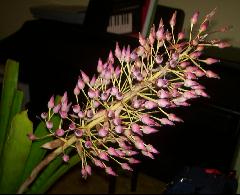
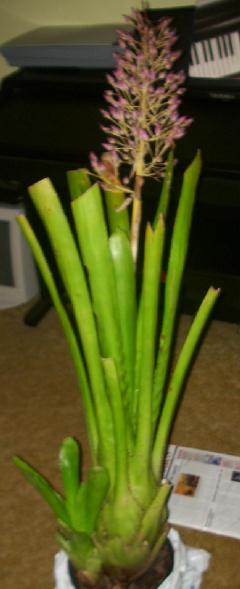


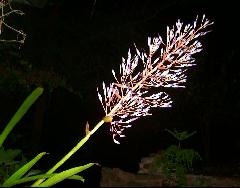
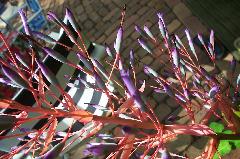

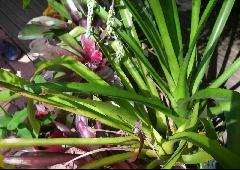
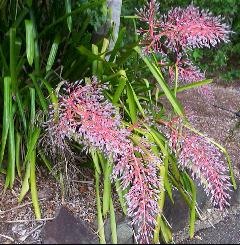


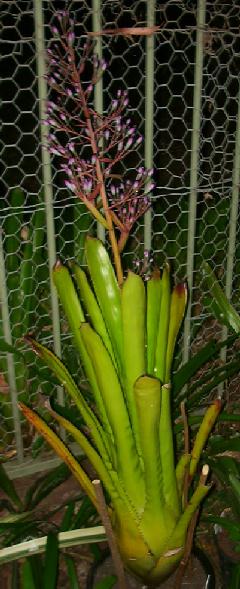
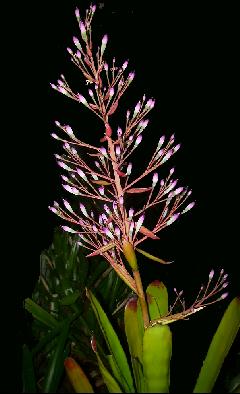
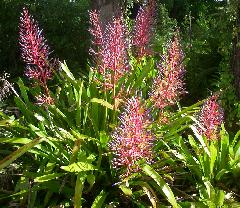
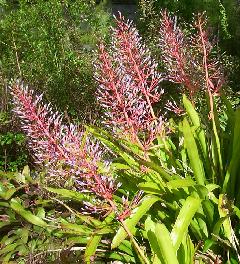
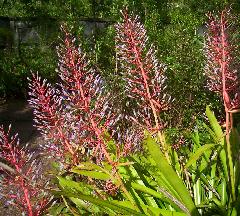
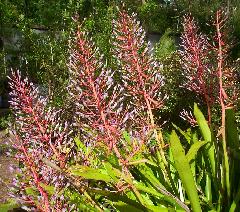

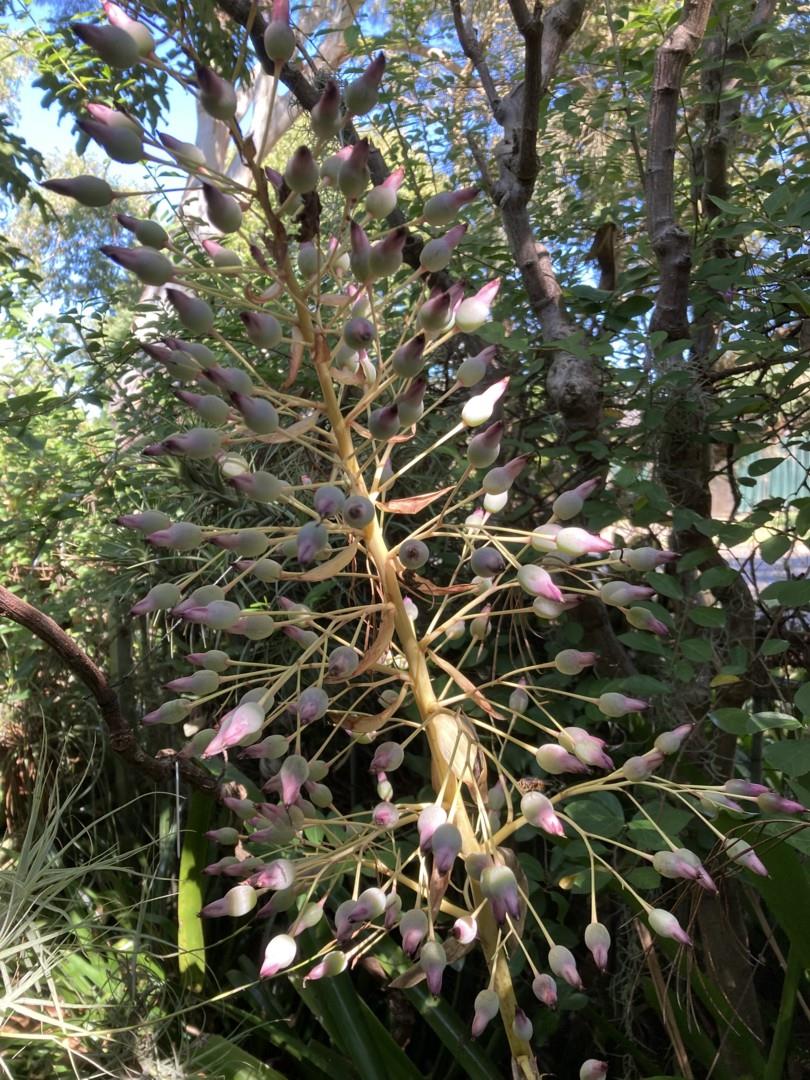
translated by Butcher
Plant without stem,
Leaves straplike subcoriaceous base clearly dilated obscure lepidote tip rounded cuspidate, spines on the edges horny dark chestnut brown lower ones close large upper ones gradually smaller and more sparse,
Flowers in an ample thyrsoid panicle with corymbose branches,
Primary bracts small lanceolate,
pedicels elongate erect,
ovary oblong glabrous,
sepals coriaceous oblong-lanceolate mucronate longer than the ovary,
petals a little narrowed.
Rio Janeiro, Glaziou 18565.
Leaves 2ft long, at the middle about 1 in. wide, base dilated oblong 6-7 in. long, 4 in. wide. Panicle 1ft long, lower pedicels 1.5-2 in. long. Calyx (including the inferior ovary) just under 1 in. long.
See herbarium specimen and compare with herbarium specimen of Portea noettigii.
Mez in 1935 treated this species as a synonym of Portea noettigii. Smith in 1943 in Arq. Bot. S Paulo II. I: 113. 1943 concurred with this move but treated it at varietal level when he described Portea petropolitana var. extensa.
I can see little difference between the two herbarium specimens of P. noettigii (Glaziou 18564 at Kew) and P. orthopoda (Glaziou 18565 at Kew) but a great deal of difference between the herbarium specimen for Portea petropolitana var. extensa. (Foster196 GH). You will also note on the New York specimen (Foster 196) for Portea petropolitana var extensa a determination by Coffani-Nunes in 2005 that confirms the name with no mention of P. orthopoda. There is no notation on the holotype held at Harvard! It is no wonder I am confused!
Because this seems in contradiction to that found by Coffani-Nunes in preparing his thesis by resurrecting 'orthopoda' to Portea orthopoda and placing Portea petropolitana var extensa under synonymy, I asked both Coffani-Nunes and Wanderley for advice. I was ignored, so despite the 2008 binomial listing accepting this move I still await some explanation. Any other clues would be appreciated.
17 Aug 2009
From: "Harry Luther"
To: "derek butcher"
Dear Derek; there are some habit differences in these 3 taxa. My problem has always been between P. p. var noettigii and P. silveirae, the latter supposedly very furfuraceous. A good example of Portea petro is P. 'Jungles', (an unregistered cultivar name – Butcher) we all know the type clone of var. extensa (orthopoda), both have different foliage and conformation. - HEL
PS All three specimens are orthopoda
Summary by Butcher 9/2009
We are now lead to believe that Portea petropolitana var. petropolitana, Portea petropolitana var noettigii, and Portea orthopoda are different but nobody will say how different, even Coffani-Nunes and Wanderley! Are they based on relative lengths of branch or pedicel or not? To identify 'noettigii' we are left with a plate and description. I would prefer to follow Smith and Mez in that 'noettigii' is synonymous with 'orthopoda' rather than an unproven statement by a taxonomist new to the job.
None of the current European taxonomists are prepared to accept the move at the present time.
My philosophy is when in doubt leave it as the status quo. This has been further strengthened these days of computer access to original documents where I have been able to prove wrong assumptions made in the past regarding synonyms etc. Here we do not even have access to such documents.
Comment by Butcher 2010.
New genus name accepted in Binomials 12, 2010. Is this an accepted publication? If not, where is the publication in Brazil? I think not because the IPNI have not recorded the change of name. Elton Leme advises it is not the intention of the writers to actually publish!
By the way, in the BSI Binomial list 2008 there was a new genus by the name of Lapa to cover the yellow flowered Orthophytum. Eventually, we may see this as Lapanthus. Regrettably this announcement was premature as there is already a genus Lappa for some algae or something.
Key to Varieties of Portea petropolitana
1. Branches of the inflorescence elongate.
- 2. Pedicels 10-15 mm long => var. petropolitana.
- 2. Pedicels 35-40 mm long => var. extensa.
1. Branches of the inflorescence shorter than the pedicels; pedicels 20-40 mm long => var. noettigii.
Portea petropolitana var. petropolitana
Aechmea petropolitana Wawra, Oesterr. Bot. Zeitschr. 30: 116. 1880.
Portea glaziovii Baker, Handb. Bromel. 22. 1889. Type. Petropolis, Rio de Janeiro, Brazil, Glaziou 12230 (K, photo GH).
Streptocalyx podantha Baker, Handb. Bromel. 32. 1889. Type. Petropolis, Rio de Janeiro, Brazil, Glaziou 16417(K, photo K 7418; US).
Branches of the inflorescence elongate;
Pedicels 10-15 mm long.
Type. Wawra 11-63 (holotype W lost, typified by original description and subsequent plate: Wawra, It. Sax. Cob. 1: 146, pI. 34, fig. A. 1883), Petropolis, Rio de Janeiro, Brazil, Jun 1879.
Distribution. Terrestrial in forest and coastal scrub, central eastern Brazil.
BRAZIL. Espirito Santo: Vitoria, 13 Ju11939, Foster 194 (GH). (Guanabara): Morro Queimado, Rio de Janeiro, 17 Jan 1932, Brade 11271 (R).
From Baker 1889
3. PORTEA GLAZIOVII Baker.
Leaves lorate from an oblong base 9-12 in. long, 4-6 in. broad; blade above the base 2 ft. long, 2-2.5 in. broad at the middle; texture. moderately firm; upper surface naked; apex deltoid-cuspidate; marginal prickles small, close, dark brown, lanceolate, the lower 1/8-1/6 in. long. Inflorescence a lax panicle above a foot long, 4-5 in. broad; branch-bracts small, lanceolate, the lower only 1.5-2 in. long; lower branches compound; pedicels ascending, glabrous, .5-.75 in. long. Ovary clavate, glabrous, .3-.5 in. long; calyx as long as the ovary; segments twice as long as the tube, ovate, with a large cusp. Petals protruded .5 in. from the calyx.
Hab. Brazil, Glaziou 12230! Received in Jan., 1881.
From Baker 1889
8. STREPTOCALYX PODANTHA Baker.
Leaves lorate from an oblong base 5-6 in. long, 4-4.5 in. broad; blade 2 ft. long, 2 in. broad, moderately firm in texture, nearly glabrous; teeth close, brown, the lower 1/6 in. long. Peduncle stout; upper bract-leaves large, red, scariose. Inflorescence a lax, tripinnate panicle 2 ft. long ; branches 8-5 in. long, only a few of the lowest compound; branch-bracts small, ovate; pedicels erecto-patent, .5-.75 in. long, with a minute basal bract. Calyx with ovary .75 in. long; sepals ovate, minutely mucronate, shorter than the ovary. Petal-blade narrow .75 in. long.
Hab. South Brazil Glaziou, 16417!
Portea petropolitana var. extensa L. B. Smith, Arq. Bot. S. Paulo II. 1: 113, pl. 116. 1943.
Branches and pedicels both elongate,
Pedicels very slender, 35-40 mm long.
Type. Foster 196 (holotype, GH; clonotype, US), Vitoria, Espirito Santo, Brazil, 13 Jul 1939.
Distribution. Ca 100 m alt, central eastern Brazil.
BRAZIL. Rio de Janeiro: Mage, 10 Oct 1920, Patschke 105 (B); Petropolis, Foster 498 (GH).
Portea petropolitana var. noettigii (Wawra) L. B. Smith, Arq. Bot. S. Paulo II. I: 113. 1943.
Aechmea noettigii Wawra, Oesterr. Bot. Zeitschr. 30: 117. 1880.
Portea gardneri Baker, Handb. Bromel. 21. 1889. Type. Sao Caetano, Minas Gerais, Brazil, Gardner 5234 (BM, photo US), Oct 1840.
Aechmea microthyrsa Baker, Kew Bull. 198. 1892. Type. Rio de Janeiro, Brazil, Glaziou 18564 (K, photo K 7419).
Streptocalyx orthopoda Baker, Kew Bull. 198. 1892. Type. Maui, Rio de Janeiro, Brazil, Glaziou 18565 (K, photo K 7420, 7421 ; P, US).
Portea noettigii (Wawra) Mez, Mart. Fl. Bras. 3(3): 296. 1892.
Branches of the inflorescence shorter than the pedicels,
Pedicels 20-40 mm long.
Type. Wawra 11-108 (holotype W lost, typified by original description and subsequent plate: Wawra, It. Sax. Cob. 1: 147, pl. 24. 1883), Entre Rios, Rio de Janeiro, Brazil, Jun 1879.
Distribution. Border of woods and coastal scrub (restinga), central eastern Brazil.
BRAZIL. Minas Gerais: Juiz de Fora, Oct 1910, Hoehne s n (SP); Jequitinhonha, Serra da Sapucaia, 3 Sep 1959, Magalhaes 15571 (RB); Coronel Pacheco, 6 Jul 1967, E. Pereira 10593 (HB). Rio de Janeiro: Maui, Ule 4042 (R, US). (Guanabara): Restinga da Tijuca, Sep 1872, Glaziou 6454 (P); Recreio dos Bandeirantes, Nov 1931, Lutz s n (OH, R, US); 827 (R).
From Baker 1889
2. Portea Gardneri Baker
Leaves ensiform from a large ovate base, above a foot long, .75-1 in. broad above the dilated base, narrowed gradually to the point, moderately firm in texture, armed with close conspicuous spreading dark brown deltoid-cuspidate marginal spines, the lower 1/6 in. long, the upper gradually smaller. Peduncle stout, flexuose, a foot long; bract-leaves spreading lanceolate, scariose, tinged with red, 6-8 in. long, spinose towards the tip. Inflorescence a dense ovoid cernuous panicle 8-9 in. long, with a furfuraceous rachis; lower branches only subtended by large lanceolate red bracts; lower branches bearing 8-12 corymbose flowers on long ascending slender furfuraceous pedicels; ovary clavate, 1/3 in. long; calyx as long as the ovary; segments as long as the tube, ovate, with a large mucro. Petals .5-.75 in. longer than the calyx.
Hab. Central Brazil; province of Minas Geraes on trees and the ground at San Caetano. Gardner 5234 ! Collected in Oct., 1840.
Detail from Mez 1935
2. Portea Noettigii (Wawra) Mez in Mart. Fl. Brasil. III. 3. (1892) 296.
- Aechmea Noettigii Wawra in Oesterr. Bot. Zeitschr. XXX. (1880) 117 et It. Sax.-Cob. (1883) 147, t. 24, 35 sect. A.
- Portea Gardneri Bak. Bromel. (1889) 21.
- Aechmea microthyrsa Bak. in Kew Bull. (1892) 198.
- Streptocalyx orthopoda Bak., 1. c.
Folia innumera, spinis ad 5 mm longis superioribus minutis dense armata, haud rubentia, e basi in apicem peracutum et spina magna badia horridum sensim angustata, ad 0.6 m longa et 23 mm lata. Scapus praesertim apicem versus furfuraceo-lepidotus, vaginis puberulis, remote serrulatis indutus. Inflorescentia laxe pyramidatim tripinnatimque panniculata, multiflora, ad 0.2 m longa et 90 mm diam. metiens, tota lepidoto-puberula; bracteis florigeris minutissimis, subfiliformibus, tomentellis. Flores pedicellis saepius ultra 20 mm longis stipitati, 30-33 mm longi. Sepala ad 10 mm longa, dorso tomentella, apice in spinulam ad 2 mm longam desinentia. Petala coerulea, ad 30 mm longa, apice acuta. Stamina filamentis ser. II. cum petalis altiuscule connatis. Ovarium puberulum, subellipsoideo-clavatum.
Brasilien : Rio de Janeiro, in der Restinga bei Tijuca (Glaziou n. 6454), bei EntreRios (Wawra It. Cob. n. 108), Restinga bei Maua (Ule n. 4042), ohne Standortsangabe (Glaziou n. 18565); Minas Geraes, bei Sao Caetano (Gardner n. 5234). - Nicht in Kultur.
translated by Butcher
Leaves innumerable, with spines to 5 mm long upper ones minute, not at all reddish, from the base gradually narrowing to a very acute tip and a strong large reddish brown spine, to 0.6 m long and 23 mm wide.
Scape especially towards the tip furfuraceous-lepidote, bracts puberulous, remote serrulate. Inflorescence lax pyramid tripinnate panicle, many flowered, to 0.2 m long and 90 mm diam., totally lepidote-puberulous;
Floral bracts very small, subfiliform, tomentose.
Flowers pedicel often over 20 mm long stipitate, 30-33 mm long.
Sepals to 10 mm long, tomentose on the back, ending in a spinulose tip to 2 mm long.
Petals blue, to 30 mm long, acute tip.
Stamens filaments ser. II. high connate with the petals.
Ovary puberulous, subellipsoid-clavate.